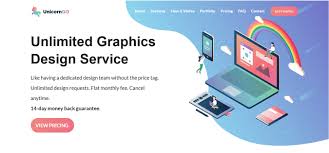Tips For Hiring The Best Designer From UnicornGo

Design brings intelligence to life. When an experience, space, communication, or product works effectively for you, it is due to the fact that a designer working behind the scenes ensured that it was created with you in mind. Although it is essential for designers to find agencies that provide them with opportunities to grow, explore, and learn, it is just as important for agencies to hire graphic designers who fully understand their methods and relate well to the type of clients the firm works with. So what needs to be considered before you hire a graphic designer?
It is not easy to find the best Agency to work with or to hire the best graphic designer. To make this process easier, we have narrowed the process down to 7 essential traits that you should look for when searching for a graphic designer to hire.
Don’t judge a book only by its cover
The entire life of a designer revolves around their portfolio. It says so much about their quality of work, capabilities, and experience. A few years ago, you would only find just a few good portfolios after looking through hundreds of them. These days, however, it is the exact opposite. There are so many resources that are available online these days, that anyone can get an impressive portfolio put together.
I believe that the true capability of a designer depends on how they identify problems and map out a journey in order to create a final product. So instead of request their portfolio, I ask designers to show me their rough sketches and process notes and attempt to understand how they came up with their solution.
Takeaway – evaluate a designer based on their methodology and thought process, and not on the finished product necessarily.
Knowledge or Education?
Don’t let education fool you. Getting a good education doesn’t always produce a great designer. Some of the finest designers that I have worked with personally have had minimal or graphic design education. Not having any formal training can actually allow a designer to break free of conventional design formulas to produce beautiful work. Of course, education is very important. However, just because someone attended a reputable institution does not guarantee the quality of their work. What is important is a person’s ability to reinvent themselves on every new project, being opening to learning something new every day, and being able to think beyond the scope. Many designers have a number of strings to their creative bow, for example unlimited content writing and content creation goes hand in hand.
Takeaway – find someone who has a strong design background but who also looks beyond the formulaic.
Artists or Designers?
Purpose is the difference between design and art. Design is a solution rather than a pretty picture. Brands are moving past positioning and aiming to serve a purpose in order to communicate and connect with their audiences. Therefore, a good design will identify the problem, determine the best solution, and serve its intended purpose. Any communication, brand, or product that works effectively is due to the fact that the designer was able to truly understand this mantra and put it into practice.
Designers who are not confident enough to defend their work or who are obsessed with the work that they do, do not understand what purpose is. Search for a designer who can defend their work based on research and rational logic, who can visualize the project from the customer’s perspective, and is open to listening to criticism.
Takeaway – hire a designer who takes a solution-oriented approach.
Break Away From Silos
Graphic Designer, Industrial Designer, Communication Designer, Interior Designer, Product Designer, etc. are simply labels that are given to you by education. A good designer attempts to break free of these labels and can visualize across the entire spectrum- three-dimensional or two-dimensional, experiential, print, or digital.
Takeaway – hire a courageous explorer.
Non-Trending
There are new communication and design trends every year. Although those trends may be great for short-term designs and communication, when you are trying to create a brand identity they can be a trap. Trends have short lives, while a brand is intended to be timeless. That is why it is critical to have a designer who does not get carried away easily by the latest design trends, who understands the difference between fashion and fad and can evaluate how a particular trend should be used.
Takeaway – when assessing a designer’s work, ask yourself if it is likely to remain relevant 5 to 10 years into the future.
Human first, Graphic Designer second
This probably holds true for a majority of jobs and is potentially the hardest thing to detect when trying to hire a graphic designer. As previously mentioned, the design needs to serve a purpose and that comes from thoroughly understanding consumers. Empathy and sensitivity are required, along with being able to see put yourself in the consumer’s shoes, along with their aspirations, culture, and socioeconomic standing.
A designer who genuinely understands users will always be able to come up with the most effective solutions. Although not always accurate, knowing what a designer does outside of work is always a good thing to know.
Takeaway – being passionate about a cause indicates higher empathy.
Adaptability vs. Experience
Experience is always a very good thing. However, having experience without any diversity can potentially be a problem. We have encountered many brilliant designers with extensive experience, but their work was lacking in diversity. They frequently being having plenty of energy, but then over the years end up churning out work that tends to all look very similar.